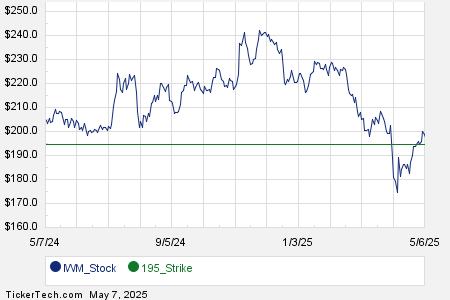AMD Reports Strong Q1 2025 Earnings Surpassing Expectations
Advanced Micro Devices (NASDAQ: AMD) saw a 1.8% increase in its share price during Tuesday’s after-hours trading. This uptick followed the release of the chipmaker’s first-quarter 2025 financial report.
The rise in AMD’s stock was fueled by impressive revenue and earnings results for the first quarter, as well as optimistic guidance for the second quarter. All figures came in above Wall Street projections.
Highlights from AMD’s Financial Performance
| Metric | Q1 2024 | Q1 2025 | Change YOY |
|---|---|---|---|
| Revenue | $5.47 billion | $7.44 billion | 36% |
| GAAP Operating Income | $36 million | $806 million | 2,139% |
| Adjusted Operating Income | $1.13 billion | $1.78 billion | 57% |
| GAAP Net Income | $123 million | $709 million | 476% |
| Adjusted Net Income | $1.01 billion | $1.57 billion | 55% |
| GAAP Earnings Per Share (EPS) | $0.07 | $0.44 | 529% |
| Adjusted EPS | $0.62 | $0.96 | 55% |
Data source: Advanced Micro Devices. GAAP = Generally Accepted Accounting Principles. YOY = Year Over Year.
Investors should pay attention to the adjusted figures, which exclude one-time expenses. Wall Street had anticipated adjusted EPS of $0.93 on revenue of $7.12 billion. AMD not only exceeded these forecasts but also topped its own revenue guidance of $7.1 billion.
During this quarter, AMD generated $939 million in cash from operations, marking an 80% increase compared to the prior year. The company ended the quarter with cash and equivalents, plus short-term investments, totaling $7.3 billion, up from $5.1 billion last quarter. However, long-term debt increased to $3.2 billion from $1.7 billion due to a $1.5 billion debt issuance intended for its ZT Systems acquisition.
Completion of ZT Systems Acquisition
In March, AMD finalized its $4.9 billion acquisition of ZT Systems, recognized as a key provider of AI and compute infrastructure for major hyperscale providers. This move aims to enhance AMD’s ability to deliver comprehensive AI solutions for data centers, an area where Nvidia has seen significant growth.
Performance Across AMD’s Business Segments
| Segment | Q1 2025 Revenue | Change YOY | Change QOQ |
|---|---|---|---|
| Data Center | $3.67 billion | 57% | (5%) |
| Client* | $2.29 billion | 68% | Flat |
| Gaming* | $0.64 billion | (30%) | 15% |
| Embedded | $0.82 billion | (3%) | (11%) |
| Total | $7.44 billion | 36% | (3%) |
Data source: Advanced Micro Devices. *Client and gaming are reported as a single segment for clarity. YOY = Year Over Year. QOQ = Quarter Over Quarter.
The growth in the data center segment stemmed from high demand for AMD’s EPYC CPUs and Instinct GPUs that support AI functionalities. During the earnings call, CEO Lisa Su noted:
Our data center AI business saw significant double-digit revenue growth annually, driven by MI325X shipments supporting cloud and enterprise deployments. Over 35 MI300-series platforms are now in production among leading service providers, boosting Instinct GPU deployments across cloud, enterprise, and AI customers.
Client revenue surged by 68% year-over-year, thanks to strong demand for the latest Zen 5 Ryzen processors. In contrast, gaming revenue fell 30% due to a decrease in semi-custom revenue.
Second-Quarter Guidance and U.S. Export Controls
For the second quarter, AMD’s management projects:
- Revenue of $7.4 billion, reflecting a 27% year-over-year increase. This estimate accounts for an anticipated $700 million revenue reduction linked to new U.S. export controls, according to CFO Jean Hu.
- Adjusted gross margin of 43%, which is a significant drop from the 54% in the reported first quarter due to planned charges for inventory reserves relating to the export regulations. Excluding these charges, the adjusted gross margin would be around 54%.
Prior to the report, analysts had estimated Q2 revenue could reach $7.24 billion, indicating AMD’s guidance provides a favorable outlook.
The new export controls implemented in April restrict the sale of advanced AI chips to China and other select markets, citing national security concerns. These restrictions prevent AMD from selling its Instinct MI308 GPU to these regions, similarly affecting Nvidia.
For the full-year 2025, AMD anticipates a $1.5 billion revenue impact from these export regulations, as noted by Hu during the call.
Conclusion on AMD’s Earnings Report
AMD delivered strong first-quarter results, highlighting that adjusted EPS growth outpaced revenue growth, which signals an increase in profit margins.
The projected 27% revenue growth for the second quarter stands out favorably, especially considering the anticipated sales loss from the MI308 chip to China.
Is Now a Good Time to Invest in AMD?
Investors considering AMD should evaluate the following:
AMD was not included among the ten stocks recently highlighted by an analyst team as top investment opportunities. This group’s picks are believed to offer robust potential returns in the coming years.
For example, if an investor had placed $1,000 in Netflix on December 17, 2004, that investment would have grown to $611,589. Similarly, a $1,000 investment in Nvidia on April 15, 2005, would be worth $697,613 today.
While noteworthy, it’s important to remember that recent performance varies and past returns do not guarantee future results.
The views and opinions expressed herein are those of the author and do not necessarily represent those of Nasdaq, Inc.



